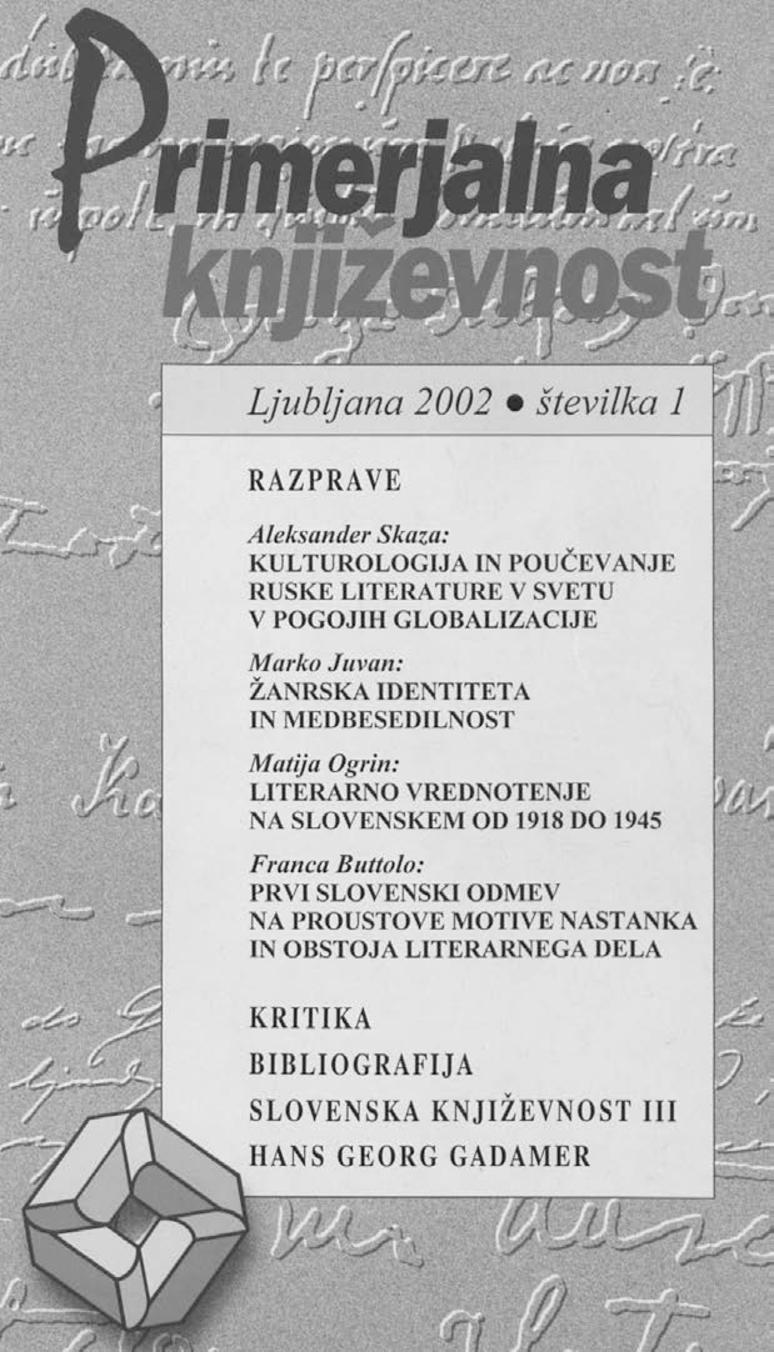Žanrska identiteta in medbesedilnost
Ključne besede:
literarna teorija, literarni žanri, žanrska književnost, medbesedilnost, intertekstualnostPovzetek
Antiesencializem je v genologiji privedel do teze, da so zvrsti in žanri zgolj sistemi razlik brez določljive formalne ali vsebinske substance, ki bi se jo dalo pokazati v besedilih. Danes lahko s pomočjo koncepcije medbesedilnosti žanrsko identiteto pojasnimo drugače: žanri živijo od družbenih praks, ki okvirjajo medbesedilne in metabesedilne navezave ter sklicevanja na prototipska besedila, besedilne nize.Literatura
ANGENOT, Marc (1983): »Intertextualité, interdiscursivité, discours social.« Texte 2. 101–112.
BAHTIN, Mihail (1999): »Problem govornih žanrov.« Prev. H. Biffio. Bahtin, Estetika in humanistične vede. Ur. A. Skaza. Ljubljana: Studia humanitatis. 229–282.
BARTHES, Roland (1970): S/Z. Pariz.
--- (1981): »Textual Analysis of Poe’s ’Valdemar’.« Untying the Text. Ur. R. Young. London–New York: RKP. 133–161.
DERRIDA, Jacques (1980): »The Law of Genre.« Prev. A. Ronell. Critical inquiry VII. 55–81.
DOLEŽEL, Lubomír (1990): Occidental Poetics: Tradition and Progress. Lincoln–London: University of Nebraska Press.
FISHELOV, David (1993): Metaphors of Genre: The Role of Analogies in Genre Theory. Pennsylvania: The Pennsylvania University Press.
FOWLER, Alastair (1982): Kinds of Literature: An Introduction to the Theory of Genres and Modes. Oxford: Clarendon Press.
GENETTE, Gérard (1982): Palimpsestes: La littérature au second degré. Pariz.
--- (1986): »Introduction à l’architexte.« Théorie des genres. Ur. G. Genette in T. Todorov. Pariz: Seuil. 89–159.
GŁOWIŃSKI, Michał (1986): »O intertekstualności.« Pamiętnik literacki 77/4. 75–100.
--- (1989): »Les genres littéraires.« Théorie littéraire: Problèmes et perspectives. Ur. Marc Angenot, Jean Bessière et al. Pariz: PUF. 81–94.
HEMPFER, Klaus W. (1973): Gattungstheorie. Information und Synthese. München: Fink.
HOORN, Johan F. (2000): »How Is Genre Created? Five Combinatory Hypotheses.« CLCWeb 2/2. 9 str. http://clcwebjournal.lib.purdue.edu/clcweb00-2/hoorn1-00.html.
JAMESON, Fredric (1981): The Political Unconscious: Narrative as a Symbolic Act. Ithaca: Cornell University Press.
JUVAN, Marko (1997): Domači Parnas v narekovajih: Parodija in slovenska književnost. Ljubljana: LUD Literatura.
--- (2000a): »On Literariness: From Post-Structuralism to Systems Theory.« CLCWeb 2/2. 13 str. http://clcwebjournal.lib.purdue.edu/clcweb00-2/juvan2-00.html.
--- (2000b): Intertekstualnost. Ljubljana: DZS. (Literarni leksikon 45.)
KEUNEN, Bart (2000): »Bakhtin, Genre Formation, and Cognitive Turn: Chronotopes as Memory Schemata.« CLCWeb 2/2. 16 str. http://clcwebjournal.lib.purdue.edu/clcweb00-2/keunen00.html.
KMECL, Matjaž (1996): Mala literarna teorija. 4., popravljena in dopolnjena izdaja. Ljubljana: Založba M & N.
KOS, Janko (2001): Literarna teorija. Ljubljana: DZS.
KRISTEVA, Julia (1969): Sèméiotikè : Recherches pour une sémanalyse. Pariz.
LEITCH, Vincent B. (1992): Cultural Criticism, Literary Theory, Poststructuralism. New York: Columbia University Press.
MARGOLIS, Joseph (1996): »Essentialism.« A Dictionary of Cultural and Critical Theory. Ur. Micahel Payne. Oxford: Blackwell. 176–178.
PAVLIČIĆ, Pavao (1983): Književna genologija. Zagreb: Sveučilišna naklada Liber.
SCHAEFFER, Jean-Marie (1989a): Qu’est-ce qu’un genre littéraire? Pariz: Seuil.
--- (1989b): »Literary Genres and Textual Genericity.« The Future of Literary Theory. Ur. R. Cohen. New York–London. 167–187.
SKWARCZYŃSKA, Stefania (1966): »Un problème fondamental méconnu de la géologie.« Zagadnienia rodzajów literackich 8/15. 17–33.
SUERBAUM, Ulrich (1985): »Intertextualität und Gattung: Beispielreihen und Hypothesen.« Intertextualität: Formen, Funktionen, anglistische Fallstudien. Ur. U. Broich in M. Pfister. Tübingen: Niemeyer. 58–77.
TODOROV, Tzvetan (1978): Les genres du discours. Pariz: Seuil.


